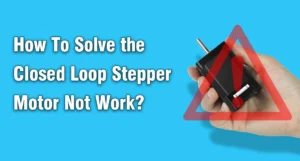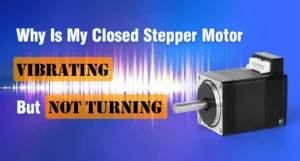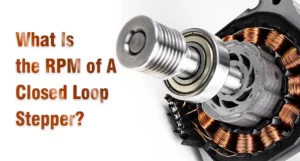Closed loop stepper motors play a crucial role in various industrial and robotic applications, providing precise control over motion. However, encountering issues where the closed loop stepper motor fails to operate can be frustrating and disruptive to operations.
Understanding how to troubleshoot and resolve these issues is essential for maintaining productivity and efficiency. In this guide, we’ll explore common reasons why closed loop stepper motors may not work and provide detailed solutions to address these issues.
How To Solve the Closed Loop Stepper Motor Not Work?
We troubleshoot and solve closed loop stepper motor issues through wire checks, motor driver tests, feedback system verification, motor setting adjustments, mechanical component inspections, software configurations, and calibration procedures.
Introduction to Closed Loop Stepper Motors
Closed loop stepper motors combine the advantages of traditional stepper motors with feedback mechanisms that ensure accurate positioning and motion control. They are widely used in CNC machines, 3D printers, robotics, and automation systems where precise movement is required.
Unlike open loop systems, closed loop stepper motors can detect errors and adjust accordingly, making them ideal for applications where reliability is paramount.
Understanding Closed Loop Stepper Motor Not Working
Despite their advanced technology, closed loop stepper motors can encounter issues that prevent them from functioning properly. Some common reasons for closed loop stepper motor failure include electrical problems, mechanical issues, software configuration errors, and feedback system malfunctions. Identifying the root cause of the problem is the first step towards resolving it effectively.

Troubleshooting Closed Loop Stepper Motor
- Checking Electrical Connections
Faulty electrical connections are a common cause of closed loop stepper motor issues. Start by inspecting all wiring connections, ensuring they are securely connected and free from damage. Use a multimeter to test for continuity and voltage at various points along the circuit. Replace any damaged wires or connectors and retest the system.
- Testing Motor Driver
The motor driver is responsible for providing power and control signals to the stepper motor. If the motor driver malfunctions, the stepper motor may not receive the proper commands to operate. Test the motor driver using a known working motor and verify that it is supplying the correct voltage and current. Replace the motor driver if necessary and recalibrate the system.
- Verifying Feedback System
Closed loop stepper motors rely on feedback from encoders or sensors to detect errors and adjust the motor’s position accordingly. If the feedback system fails, the motor may not move as expected or exhibit erratic behavior. Check the encoder or sensor for proper alignment and operation. Calibrate the feedback system according to the manufacturer’s instructions and test the motor’s performance.
- Adjusting Motor Settings
Incorrect motor settings can cause the stepper motor to behave unpredictably or fail to move altogether. Review the motor’s specifications and adjust the settings accordingly, including step resolution, current limits, and acceleration/deceleration profiles. Refer to the motor driver’s manual for guidance on configuring the settings and testing the motor after making adjustments.
- Inspecting Mechanical Components
Mechanical issues such as binding, misalignment, or excessive wear can prevent the stepper motor from operating smoothly. Inspect the mechanical components of the system, including pulleys, belts, lead screws, and bearings. Lubricate moving parts as needed and replace any worn or damaged components. Ensure that the motor shaft is properly coupled to the load and that there is no excessive backlash.
- Software Configuration
The software used to control the closed loop stepper motor must be configured correctly for the system to operate reliably. Check the software settings and parameters, including motor type, communication protocol, and motion profiles. Verify that the software is compatible with the motor driver and feedback system. Update the software if necessary and recalibrate the system to ensure proper operation.
- Calibration Procedures
Calibration is essential for ensuring accurate positioning and motion control with closed loop stepper motors. Follow the manufacturer’s recommended calibration procedures, including setting the home position, adjusting step resolution, and fine-tuning the feedback system. Use calibration tools such as dial indicators or laser alignment devices to verify the motor’s performance and make adjustments as needed.
- Preventive Maintenance Tips
To prevent future issues with your closed loop stepper motor, implement a regular maintenance schedule that includes cleaning, lubrication, and inspection of all components. Keep records of maintenance tasks performed and note any abnormalities or trends in motor performance. Train personnel on proper operating procedures and troubleshooting techniques to minimize downtime and maximize productivity.
- Seeking Professional Help
If you encounter persistent issues with your closed loop stepper motor despite following troubleshooting steps, consider seeking assistance from qualified professionals. A certified technician or engineer with experience in stepper motor systems can diagnose complex problems and provide expert guidance on resolving them effectively. Don’t hesitate to reach out for help if you’re unsure how to proceed or if the issue is beyond your expertise.
Conclusion
Closed loop stepper motors offer precise motion control and reliability for a wide range of industrial and robotic applications. However, encountering issues where the motor fails to operate can disrupt operations and affect productivity. By understanding common reasons for closed loop stepper motor failure and following detailed troubleshooting steps, you can quickly identify and resolve issues to keep your systems running smoothly.
FAQs
Q1: What are the common reasons for closed loop stepper motor failure?
A1: Common reasons include electrical problems, mechanical issues, software configuration errors, and feedback system malfunctions.
Q2: How often should I perform maintenance on my closed loop stepper motor?
A2: Maintenance frequency depends on usage and operating conditions. It’s recommended to perform regular inspections and maintenance tasks at least once every few months.
Q3: Can I use open loop stepper motors instead?
A3: Open loop stepper motors are suitable for some applications but may not provide the same level of accuracy and reliability as closed loop systems, especially in demanding environments.
Q4: Is it possible to upgrade a closed loop stepper motor system?
A4: Yes, it’s possible to upgrade components such as motor drivers, feedback systems, and software to improve performance and reliability.
Q5: How do I know if my closed loop stepper motor needs recalibration?
A5: Signs of calibration issues include erratic movement, inaccurate positioning, or difficulty maintaining speed and torque. Recalibrate the motor if you notice any of these symptoms or after making significant changes to the system.






